Sandhill Crane At Grass Lake In Ontario
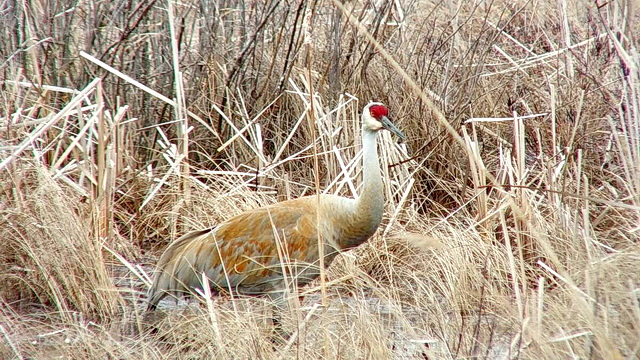
A sudden change in plans had Bob and me with a free day in which to go birdwatching, an opportunity not to be missed. Recent reports had us setting our sights on an area just west of Toronto, an area to which we had never gone birdwatching before. It promised to be a fruitful day, and sure enough, amongst other species observed, we did sight one Sandhill Crane at Grass Lake near Cambridge, Ontario.
About an hour earlier, we had driven by the marshy area known as Grass Lake where we saw a couple of other birders lingering on the roadside with their lenses trained on the marsh. Bob and I had been unable to spot any birds of note despite using our binoculars, so we drove about a quarter mile further along the dirt road and stopped near some birdhouses that were attracting the attention of a number of birds.
While observing a pair of Eastern Bluebirds and numerous Tree Swallows, we engaged some friendly birdwatchers in conversation, and one kindly gentleman offered to return to the lake with us and point out where the Sandhill Cranes were located. I was finally able to get the bird in my sights.
Even at that, it had taken us a good few minutes to pinpoint the Crane hidden there amongst the tall, brown marsh grasses. It remained stock still for long periods at a time and blended in so well because of the rusty wash on its upperparts that the bird was almost invisible to the naked eye. It’s standing in the center of this picture.
Sandhill Cranes are large heron-like birds with primarily slate-grey coloured plumage. The rust colour on the wings is largely random and attributed to the iron-rich mud with which the Cranes preen their feathers. If iron-rich mud is absent in the Cranes’ habitat, then the plumage appears grey all year long. The plumage of Sandhill Cranes in breeding season often has a more pronounced ochre colour. During the fall moult, the rust-coloured feathers will be shed, and the birds will resume their greyish appearance.
What helped us pick out the Sandhill Crane was the heart-shaped red skin on the forehead of the bird. In combination with the white cheeks, it provided sufficient contrast to the bleached grasses to help us maintain constant detection. It is only the adult Cranes that have that bare reddish patch that extends from the beak up the face towards the crown.
The day was incredibly windy with gusts bursting out of nowhere and buffeting the cameras so much that it was nearly impossible to keep the Crane in our lenses. The bobbing stems of weathered bulrushes posed an additional dilemma because they constantly played havoc with the focus of the camera.
Sandhill Cranes are the most numerous species of crane found in the world, but not all populations of these Cranes are migratory. In North America, there are six distinct Migratory Populations, and of those, the Cranes in Ontario belong to the Eastern Population, which winters in Florida and parts of southern Georgia. Their breeding grounds are primarily throughout the Great Lakes Region of the United States and Ontario.
As fellow birdwatchers will know, once you have your sights on a sought-after bird, hours can pass while you wait and watch for the bird to change its position or perhaps engage in alternate behaviour. This Sandhill Crane was very reluctant to move away from a low mound of shrubs, so we imagine that the nest was located nearby there.
Migratory Populations of Sandhill Cranes begin egg laying between early April and late May, so it makes sense that this Crane either has a nest built or is about to prepare the site for a nest. It is customary for a pair of Sandhill Cranes to build the nest together, gathering plant materials from the surrounding nesting area and tossing it over their shoulders to form a low mound.
Sandhill Cranes nest in small, isolated freshwater wetlands such as marshes, wet meadows, bogs or swales, preferring those where vegetation grows in standing water and those that are bordered by shrubs and trees. Early in the season, the Cranes use whatever dried plant materials are available to form the foundation of their nest, and these can include cattails, grasses, bulrushes or sedges. They then fashion a cup-shaped hollow into the mound using grass or willow sticks to line it. Occasionally, the Cranes will nest on dry land.
The nests may end up being 30-40 inches (76-101 cms) across and 6 inches (15 cms) high, with those over water being larger than the nests built on dry land. It is the female who takes responsibility for arranging the nesting materials. Sandhill Cranes mate for life which can be twenty years or more, and they may start breeding as young as two years of age. Then again, others may be seven years old before they are ready to breed. Cranes only raise one brood per year, with the female laying between one to three eggs. Both parents are involved in incubating the eggs.
At long last, this Sandhill Crane seemed less distracted by the presence of birdwatchers and more intent on personal grooming. It was hard to tell whether the windy conditions ruffled the feathers on this one’s neck or whether the bird had puffed them up for the purposes of preening, at which it was actively engaged. Sandhill Cranes are large birds about 3-4 feet (91-122 cms) tall with over a 5-foot (1.5 m) wide wingspan. They have unique curved or drooping rump feathers, so, all in all, there is a lot of plumage to groom.
Most of our attention was focused on the Sandhill Crane, but Bob also spotted a coyote loping across the adjacent upland. We immediately recognized the danger the coyote posed for the eggs or nestlings of the Sandhill Cranes. The male Sandhill Crane is the primary defender of the nest. Sandhill Cranes attack aerial predators such as crows, ravens, eagles or owls by leaping into the air and thrusting their feet forward. Terrestrial predators such as this coyote, foxes, raccoons, bobcats or wolves, would be met with wings spread wide, a downward-pointed bill, loud hissing and eventually forceful kicking. Stabbing with their bills is very effective; they are powerful enough to pierce the skull of a small carnivore.
Having been an extremely cold, long, snowy winter, spring thaws have left an abundance of water everywhere, and Spring Peepers already were in full song. As you can hear in our video, they were contributing their merry chorus to the symphony of birdsong provided by the throngs of Red-Winged Blackbirds populating the marsh. It was such a welcome addition to the very warm day.
Bob and I left Grass Lake for about an hour, to check out nearby F.W.R. Dickson Conservation Area, and when we returned to Grass Lake, the Sandhill Crane was pretty much in exactly the same position as when we had departed. As the afternoon waned, the Crane decided to wander closer to the open water and began foraging for food. It is customary for them to feed with their bills down to the ground while they root around for seeds, plant tubers, small vertebrates like mice and snakes, and invertebrates such as insects or worms. They do not hunt in open water or hunch their necks the way Herons do, but glean from the surface of shallow wetlands or probe with their bills.
It is common to see numerous Sandhill Cranes together in that area of southern Ontario, and indeed others had recently been spotted in nearby fields, but on the day we visited, Bob and I were only fortunate enough to see this one Crane. The mate had flown from the area earlier in the morning according to another birdwatcher. The highest breeding density of Sandhill Cranes occurs where the habitat contains open sedge meadows in wetlands adjacent to uplands of short vegetation. The area around Grass Lake seems to fit the bill perfectly.
While we photographed and recorded the Eastern Bluebirds earlier on, the telltale voice of some Sandhill Cranes could be heard in the distance. It is a distinctive, vibrant, far-reaching gar-oo-ooo that lasts a couple of seconds and is often strung together multiple times. The loud, rattling bugle-like call can be heard up to 2.5 miles (4 kms) away whether the Cranes are in flight or on the ground. Now, if only we could catch up with a massive group of these elegant birds. The sound would be deafening but the sight would be something magnificent.
Frame To Frame – Bob and Jean

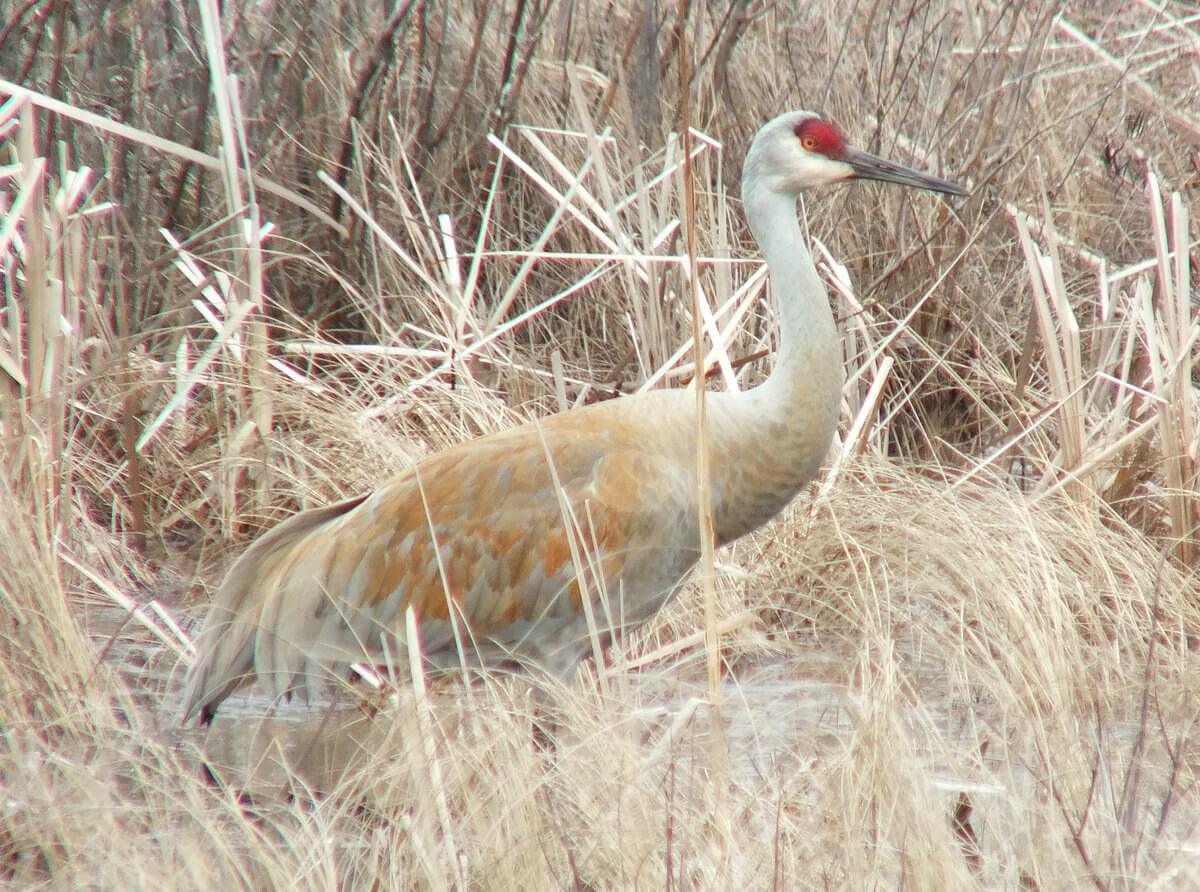


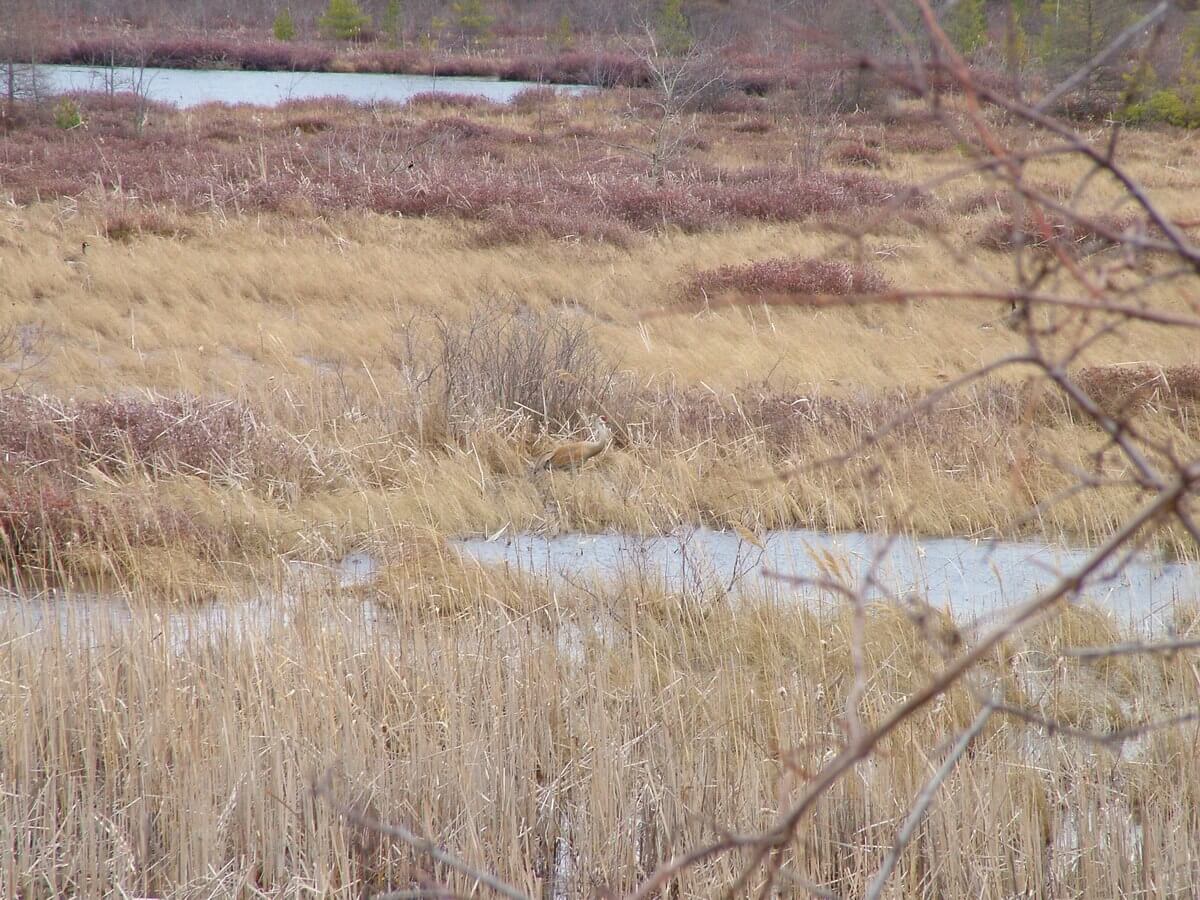
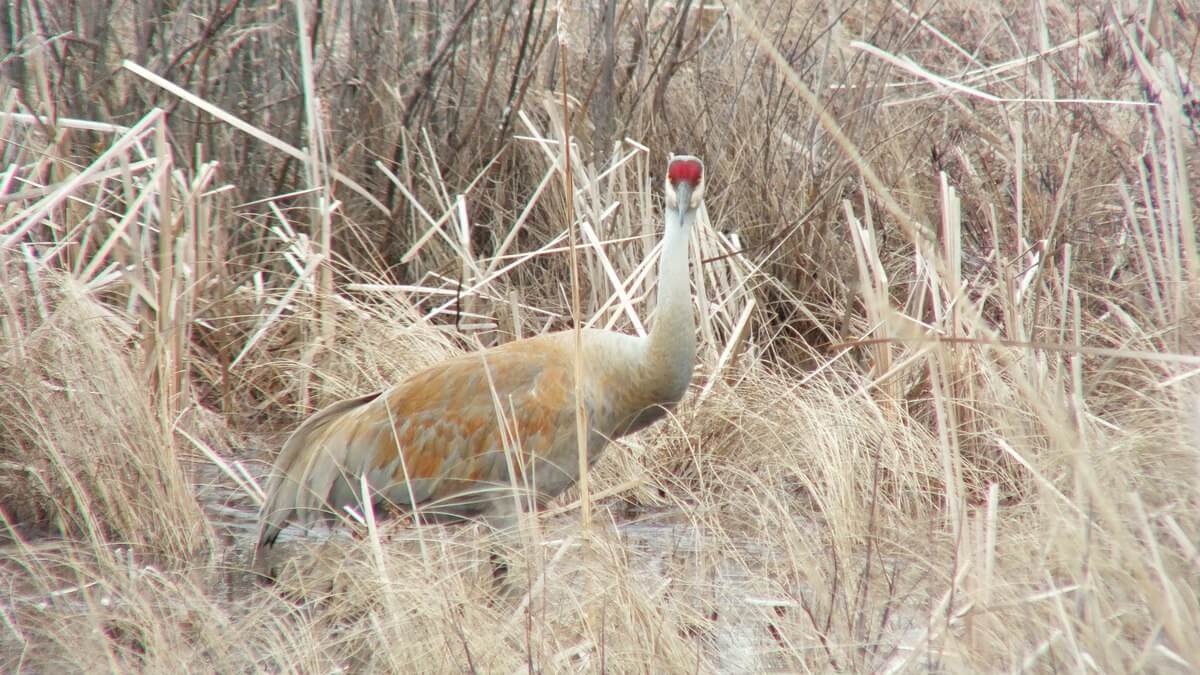
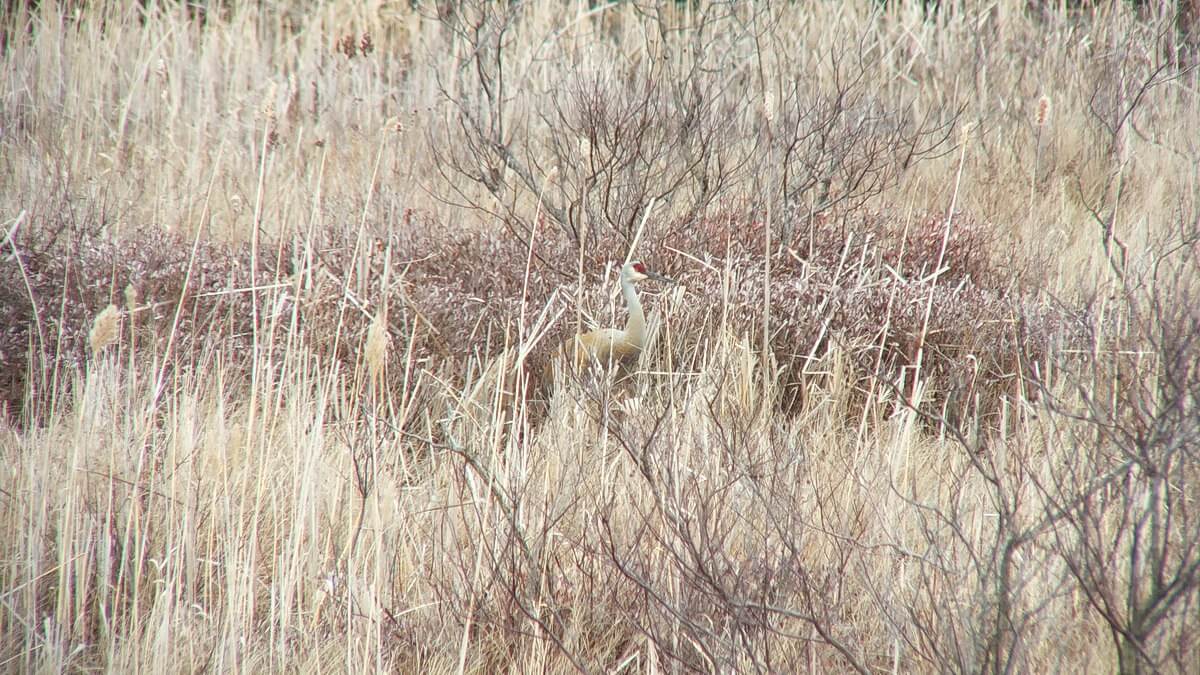
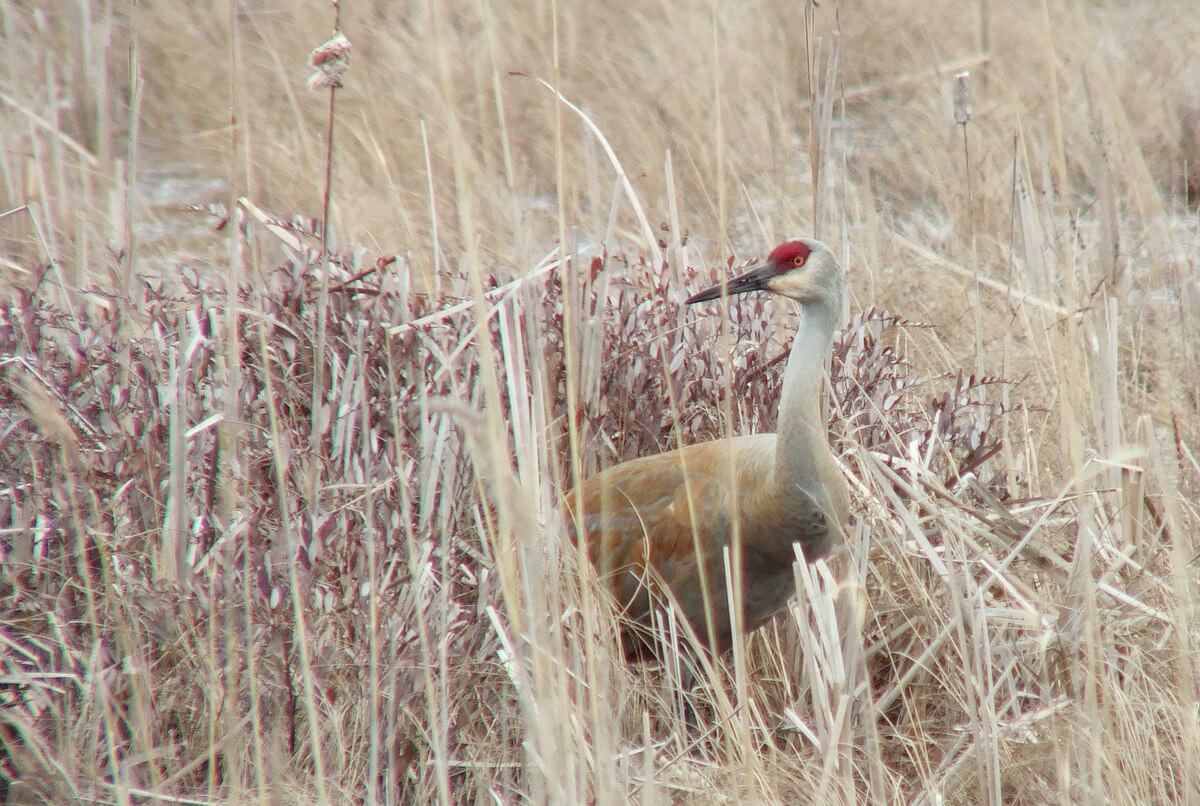
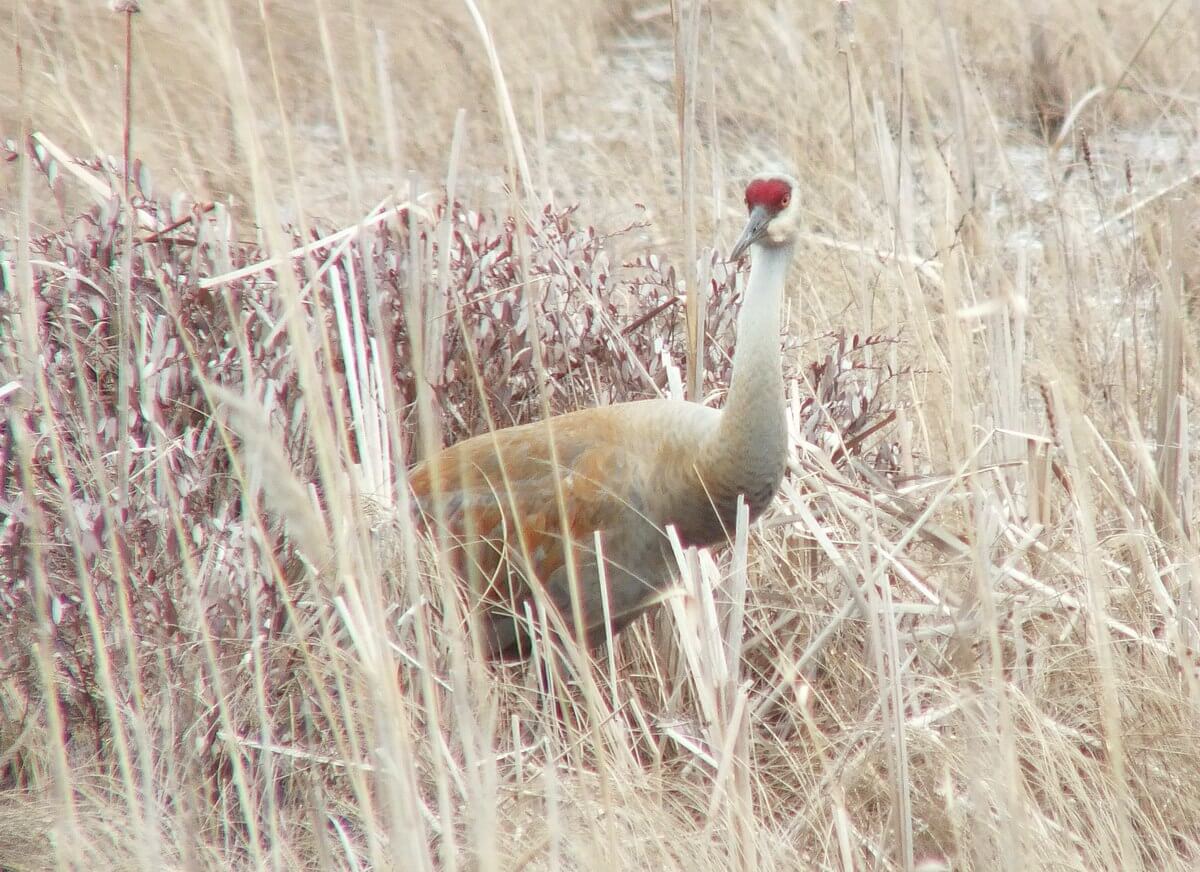
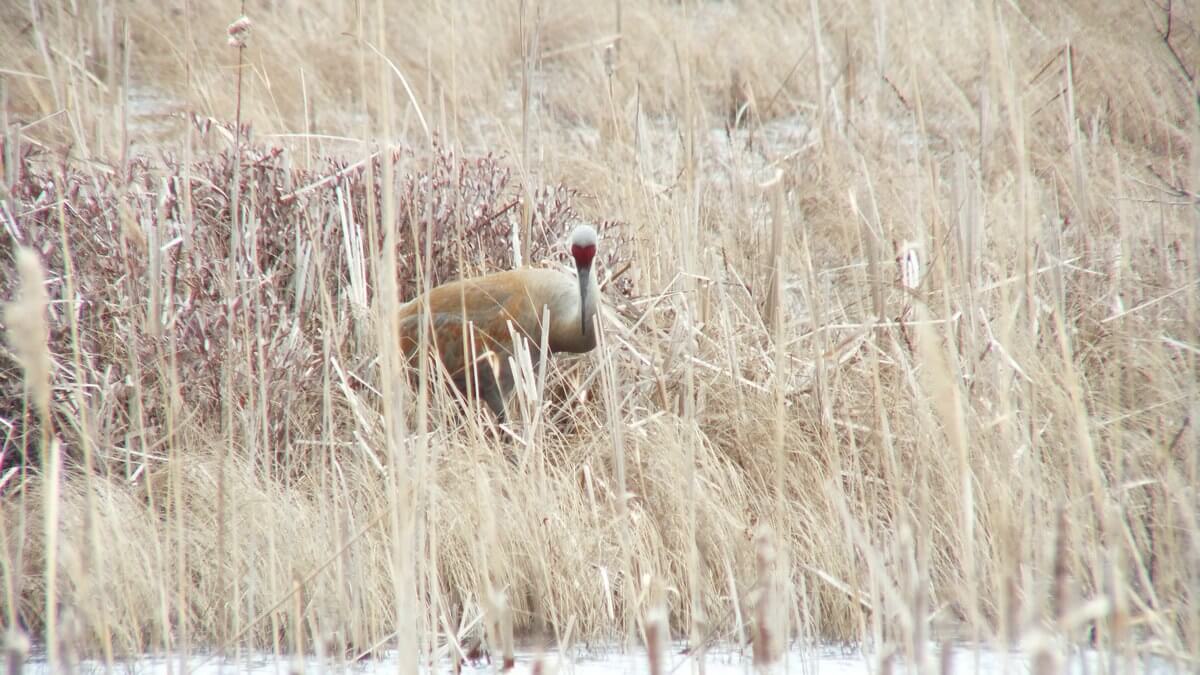
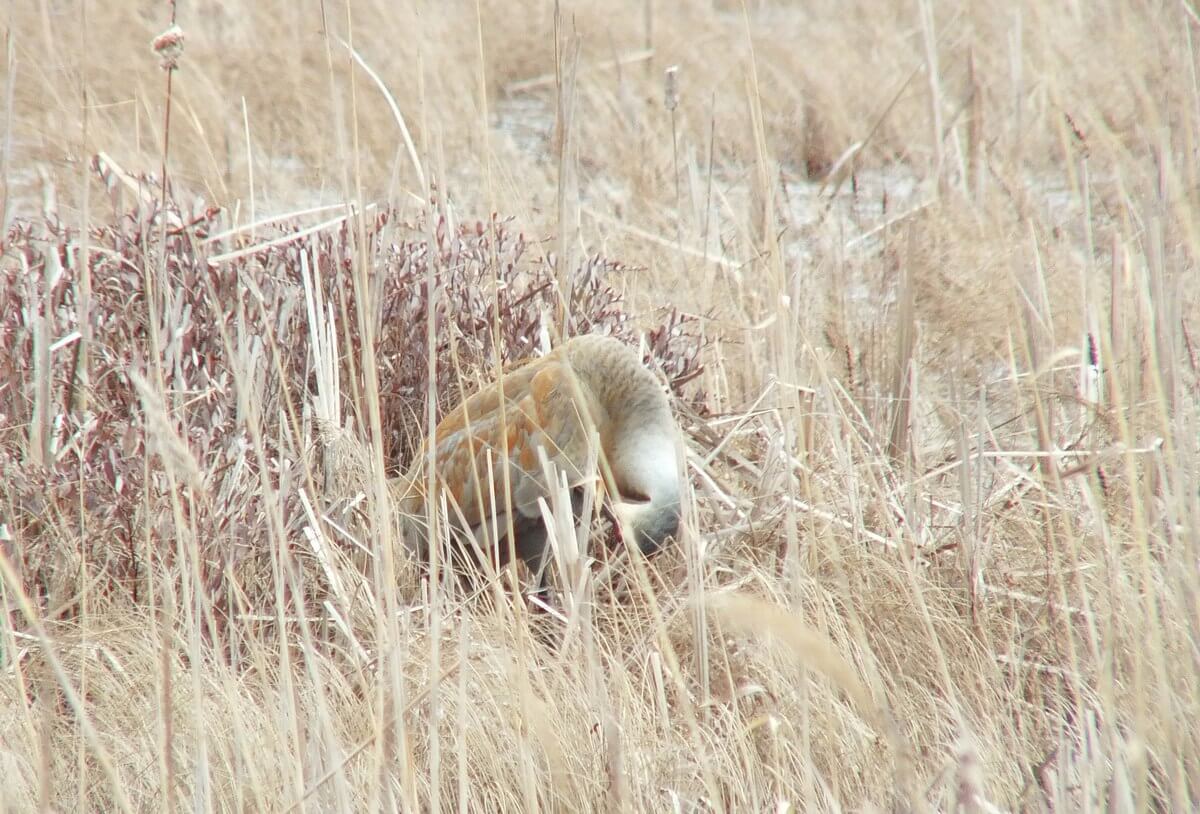

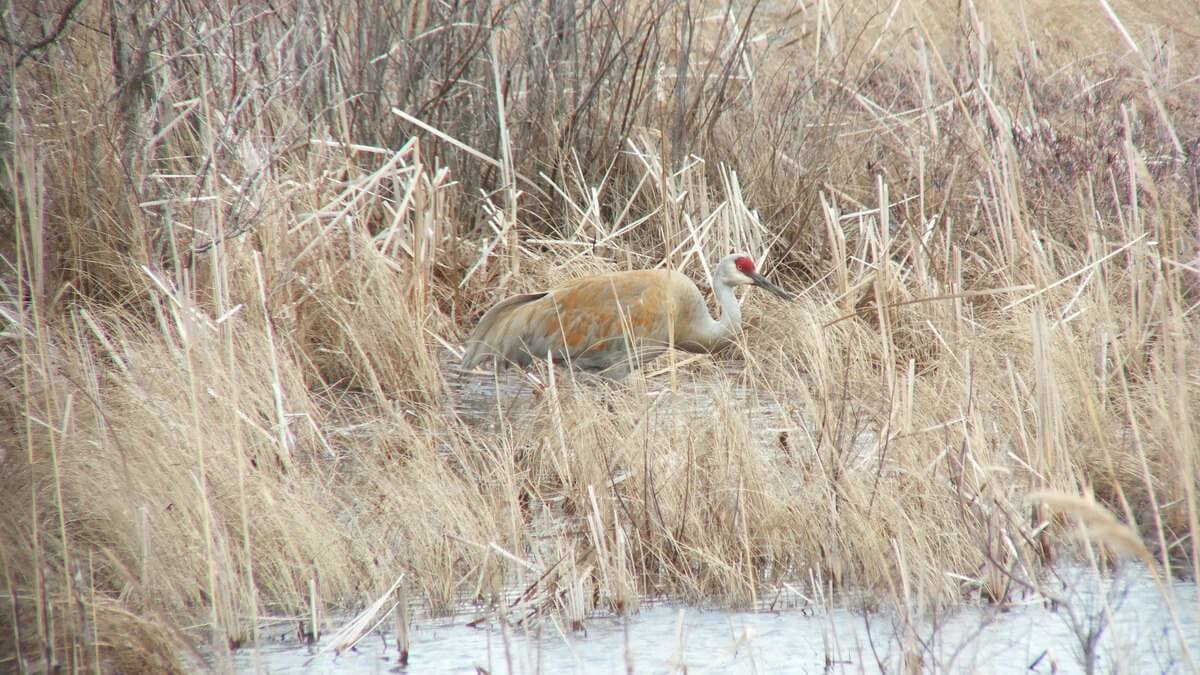


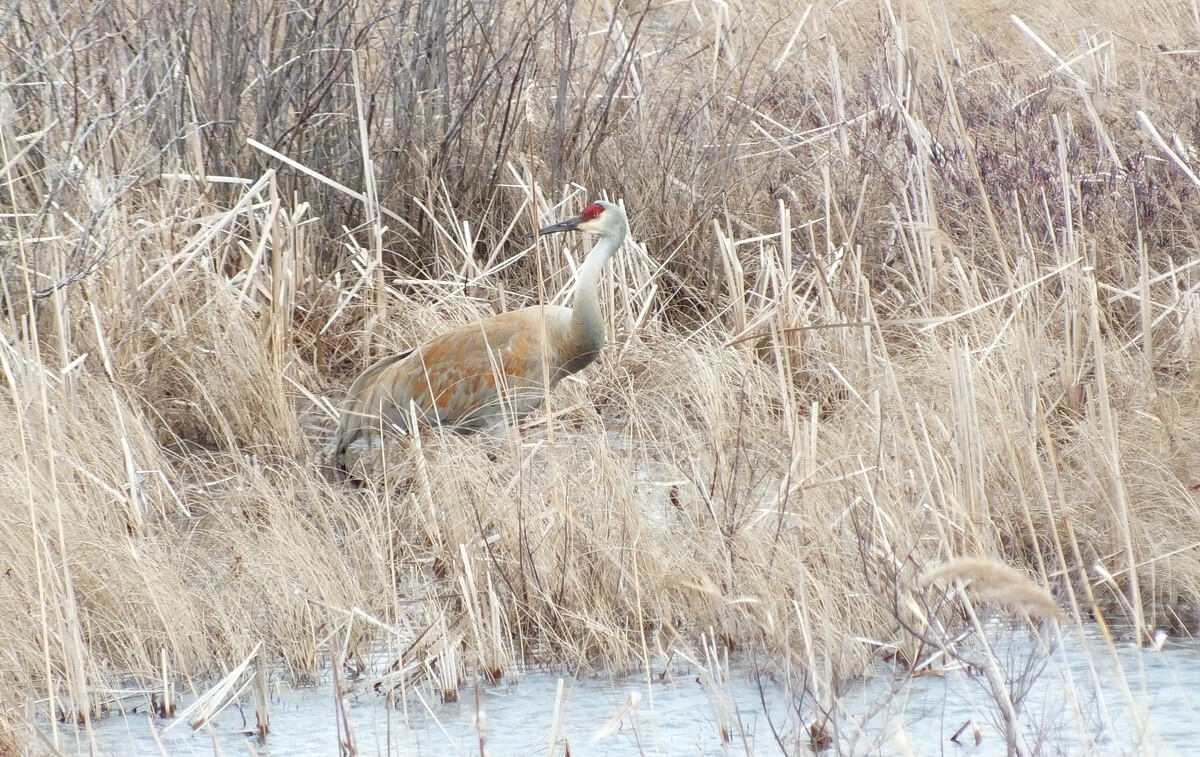
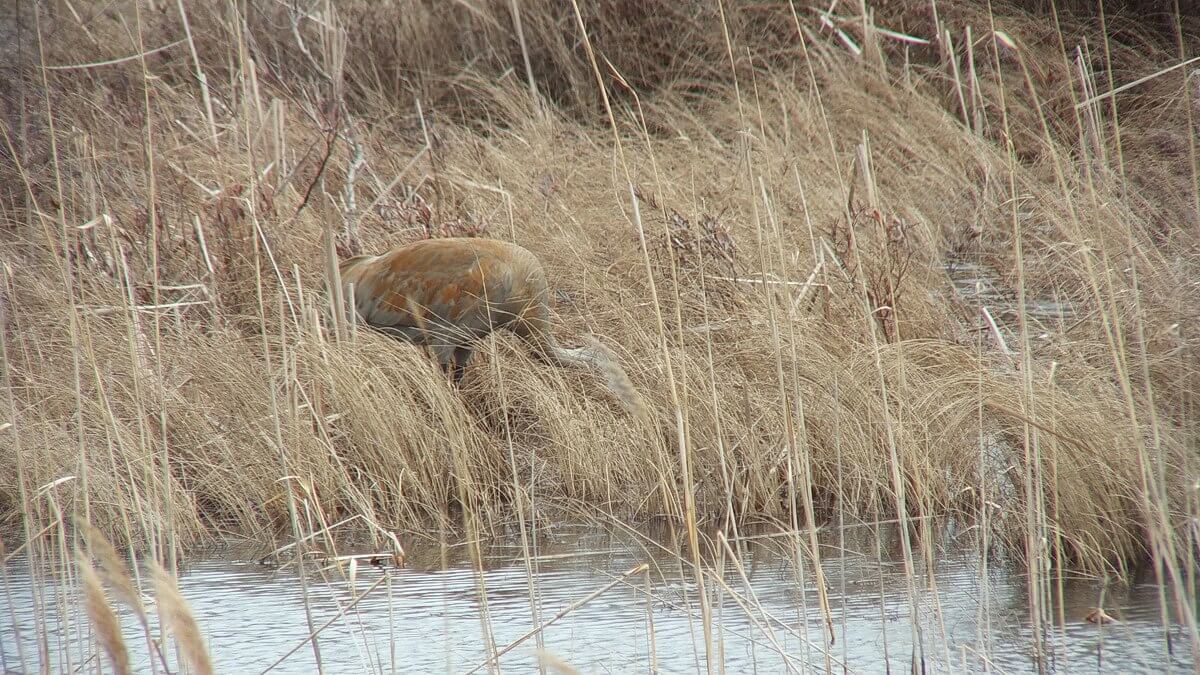
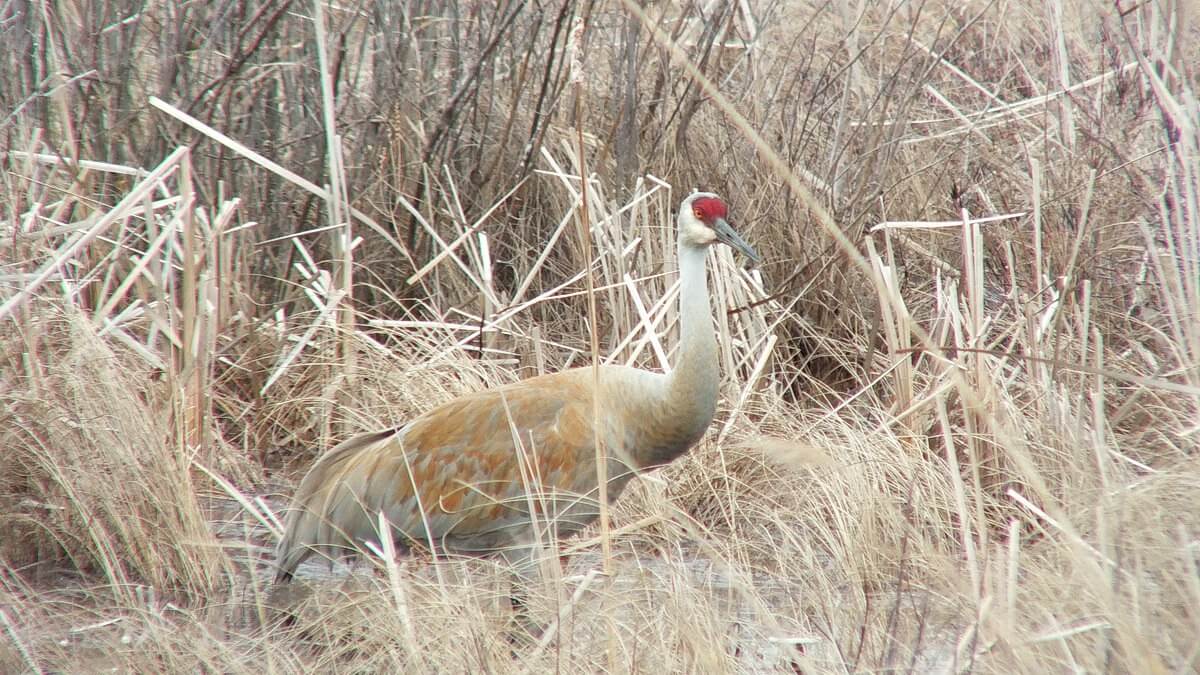
Pingback: 20160424 Brown Creeper, Wasp Ball, Flora, Sandhill Crane Migration | Brtthome's Blog